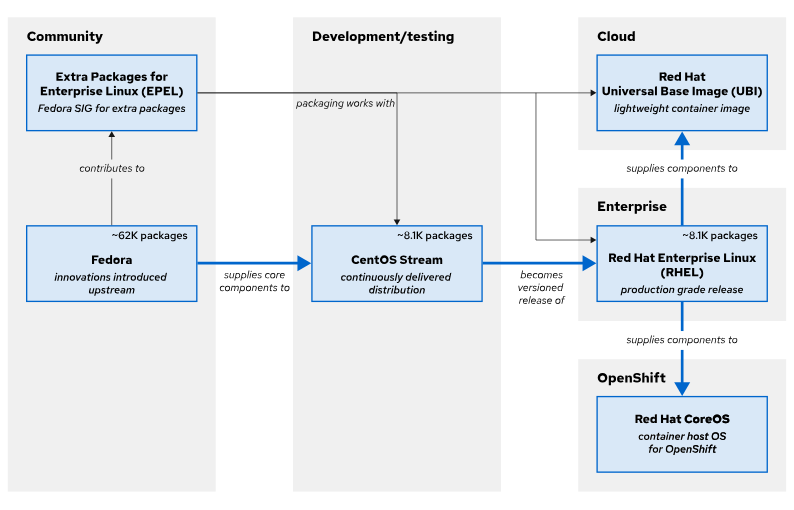리눅스 배포판들은 오픈소스로 공개된 Linux kernel을 기반으로 사용자가 사용할 수 있는 패키지와 보안 패치를 완료 후 제품으로 제공
ex) Ubuntu, RHEL, centos(지원 종료), Navix
Redhat은 다음과 같은 정책으로 배포판들을 담당함

Fedora를 베이스로 Centos Stream을 개발, 테스팅을 진행한 이후, RHEL을 제품으로 판매
기존에는 Centos가 해당 포지션이었으나, Community 버전으로 풀려있던걸 라이센스 이슈로 해당 지원을 종료함
Fedora
Community Project로 오픈소스 프로젝트
- Major update는 6개월을 주기로 관리
| Fedora | CentOS Stream | RHEL | |
|---|---|---|---|
| Expected lifecycle | 12-18 months | 5 years | 10 years |
| Software vendor certified | No | Usually not | Yes |
| Documentation provided by | Community | Community | Red Hat |
| Expert support available | No | No | Yes |
| Product security team | No | No | Yes |
| Security certifications | No | No | Yes |
| No-cost options | Yes | Yes | Yes |
| Management tools | No | No | Yes |
Quiz
- Which two statements describe the benefits of open source software for the user?
- Code can survive the loss of the original developer or distributor.
- Users can learn from real-world code and develop more effective applications.
- Which two statements describe how Red Hat develops products and interacts with the community?
- Sponsors and integrates open source projects into the community-driven Fedora project.
- (Fedora로부터 Centos Stream 프로젝트 진행)
- Participates in upstream projects.
- 먼저 오픈소스 커뮤니티(upstream)에서 개발 → 그 결과물을 Fedora/CentOS Stream/RHEL에 반영
- Which two statements describe the benefits of Linux?
- Linux is modular and can be configured for a full graphical desktop or a small appliance.
- Linux includes a powerful and scriptable command-line interface, which enables automation and provisioning.